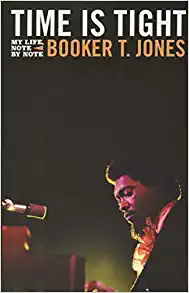
The groundbreaking, interracial Booker T. & the MG’s (“Green Onions,” “Soul Limbo,” “Time is Tight,” “Hang ‘Em High”) was one of my favorite bands of the 1960s, and I have never stopped listening to their music. The band was unusual as purely instrumental hitmakers, somewhat like the same decade’s guitar-driven The Ventures, but with the Hammond B3 organ playing of Booker T. Jones leading the way.
Jones’ life story is engagingly told in his 2019 memoir Time is Tight: My Life, Note by Note, which unfolds as a series of vignettes in 18 chapters ranging across time and space, definitely not in chronological order. As he explains in the Author’s Note: “I wanted you, the reader, to sense the flow of time—not only from early beginnings to now but jumping forward and circling back when moments were joined more by truth than minutes.”
He grew up in a loving household, and became a music prodigy in the segregated Memphis of the 1940s and 1950s. He gained early fame there as a teenager with the band’s first hit, 1962’s “Green Onions,” (recently in the spotlight for the Financial Times weekly feature “Life of a Song”), just when he was starting his studies at the renowned Jacobs School of Music at Indiana University Bloomington. He graduated from the school in 1967, and delivered a commencement address in 2012.
There is a quiet dignity about this book. While he sometimes displays a youthful sense of wonder, there is a sense that at 77 he is a wise elder of music and beyond. He is also a singer and multi-instrumentalist with a Lifetime Achievement Grammy award, and reveals himself to be a meditating, self-critical spiritual seeker. Although he remembers being a naïve youngster, he was also the de facto business manager for the MGs while still a teenager, with difficult duties like collecting the band’s pay from tough nightclub owners after gigs.
There are stories that may be unfamiliar with many readers. For instance, he produced Willie Nelson’s 1978 mega-hit album of pop standards, Stardust, as well as “Ain’t No Sunshine,” the 1971 instant classic by the late Bill Withers. “His body of work,” according to John Lingan, writing about the book in The New York Times, “spreads across whole branches in the family tree of 20th-century and 21st-century pop — you can hear him underneath Sam & Dave, the Blind Boys of Alabama, Bob Dylan, Big Daddy Kane and Valerie June.”
The MGs (inducted into the Rock & Roll Hall of Fame in 1992) were the house band for the influential Memphis-based R&B/soul independent record label Stax Records, which broke through to a major worldwide audience, and significantly influenced rock music. After considerable ups and downs with Stax, he returned to the newly reconstituted label in 2013, and tours as leader of The Stax Revue. Like Jones and his band, the company’s soon-to-be-famous 1960s artists (Otis Redding, Isaac Hayes, The Staple Singers, Albert King, Carla Thomas, and so many more), started off as local unknowns.
He introduces Redding at the beginning of Chapter 7, set in Memphis in the summer of 1962. Jones listens as Redding sits next to him at the organ at Stax’s studio and starts singing “These Arms of Mine.” But Redding was not yet a recording artist. Moments earlier, he was “gently and meticulously unloading suitcases and instruments onto the street from a vehicle parked at the curb.”
Jones further explains: “He was the driver and gofer for the next band setting up in the studio, Johnny Jenkins and the Pinetoppers, a group from Georgia. Although I hadn’t played a note at the organ, the driver, whose name turned out to be Otis, started in right on key in B flat, as if he had perfect pitch. I knew he was special.” The MGs backed him at the famed Monterey Pop Festival in June 1967.
In Chapter 11, he recounts hearing “the unthinkable news” on December 10, 1967, while in a Cincinnati airport bar with the MGs, that Redding, 26, had been killed in a plane crash in Wisconsin, along with most members of his Memphis-based touring band, Jones’ longtime friends The Bar-Kays. The MGs played on “(Sittin’ On) The Dock of the Bay,” recorded shortly before Redding’s death and later a Billboard #1 single, co-written by Redding and MGs guitarist Steve Cropper.
In the following chapter, Jones devotes five pages to the April 4, 1968 assassination of Dr. Martin Luther King Jr., at the Lorraine Motel in Memphis, where Stax musicians often convened in the dining room. “The Lorraine,” Jones writes, “provided the only suitable location where black and white could congregate without intervention. When Dr. King was shot there, it was as if the act had been carried out on our own turf– a dreadful mockery of the harmonious racial mixing that went on at the Lorraine, and of our espousing of the motel.”
A key theme in Time is Tight is family: the strong upbringing from his parents, and unsparing details about his first two marriages. He writes extensively about Nan Jones, his third wife, as well as his children and their success in fields such as business and music. He now works with many younger musicians, including his son Ted, a guitarist. His daughter Olivia, who has an MBA from the UCLA Anderson School of Management, is his manager.
In the section dated September 30, 1977, in Los Angeles, Jones writes of the moments immediately after his mother’s death from cancer: “Now I understand that’s the way life goes. It is a song sung between the verses, a game played during the time-outs. To grasp it you let it slip through your fingers.”
